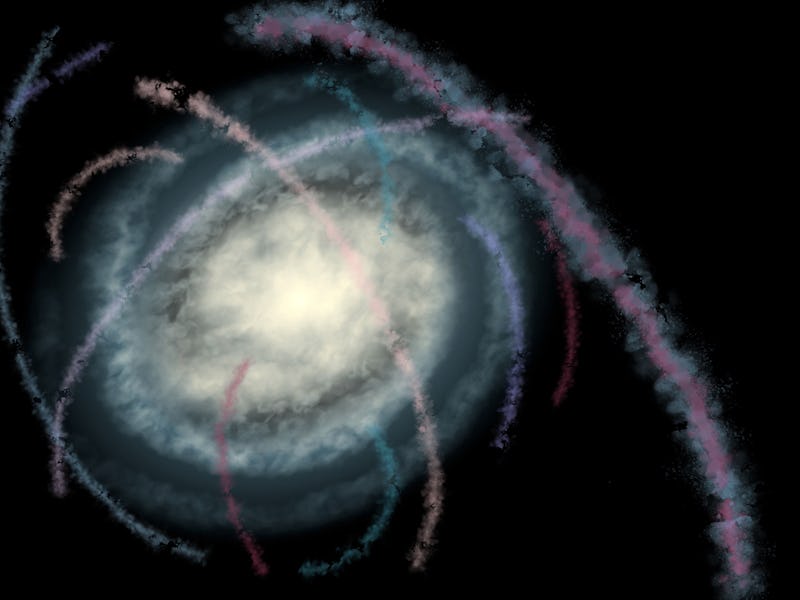These torn bits of small galaxies could reveal dark matter mysteries
A dozen groups of moving stars could point the way.

Ting Li compares dark matter to a Christmas tree on a dark night.
“If you don’t have the light there, you don’t see the tree or the shape of the tree,” the assistant professor of astronomy and astrophysics at the University of Toronto said during a press conference for the virtual 239th American Astronomical Society meeting on Tuesday. “But if you have these kinds of twinkling lights running around the Christmas tree, you will see the shape from those lights, and you want to have more lights there so that you can map the shape of the tree.”
The lights, for Li, are shredded bits of neighboring satellite galaxies or globular clusters torn apart by the Milky Way Galaxy, and are now stretched out in a stream along its orbit.
What’s new — In a forthcoming study in The Astrophysical Journal, Li and her team map out 12 stellar streams in the Milky Way to reveal the mysteries of dark matter. The study also shows the galaxy’s feeding habits as it gobbles on surrounding smaller galaxies, which can inform scientists of the Milky Way’s formation history. A preprint is available on Arvix.org.
Using the Anglo-Australian Telescope, a 4-meter optical telescope in Australia, the team behind the recent study measured the speed of stars in 12 stellar streams. They also measured the chemical composition of the stars.
This artist’s impression shows the 12 stellar streams as they orbit the Milky Way.
The study is the first of its kind to look at the properties of that many streams, while previous ones have looked at one stream at a time.
“Because we have this very good data set, we can map individual stars in the stream and know their location and their motion,” Li said. “We were able to study the feeding habits of the Milky Way to understand how the Milky Way grow up to become fatter and fatter, or heavier over time.”
What they found — By analyzing the composition of the stars, the team was able to determine which stellar streams formed from the torn bits of globular clusters of stars and which ones formed from shredded satellite galaxies near the Milky Way.
Stars stripped from a cluster all have the same chemical composition because they are born simultaneously, while stars stripped from a galaxy have differing compositions. Knowing the orbit of the stellar streams also shows when they became a part of the Milky Way, revealing how the galaxy has grown over billions of years.
“This is a very useful data set for us to study the distribution of the invisible dark matter in the Milky Way,” Li said.
Dark matter is a type of matter that doesn’t reflect, emit, or absorb light, and may only interact with other matter through gravity. Although hidden, dark matter makes up around 27 percent of all mass in the universe.
Around 68 percent of the remaining mass is dark energy, with just five percent left to ordinary “baryonic” matter, like the stuff we see every day.
But scientists have never been able to observe dark matter directly. They know it’s there, given its effect on the motion of stars and galaxies.
“We can use a group of streams to probe dark matter,” Li said.
What’s next — By mapping out the stellar streams in the Milky Way, astronomers can observe their orbit, which would provide clues to the shape of dark matter in the galaxy.
The team behind the study founded a program to measure the properties of stellar streams called the Southern Stellar Stream Spectroscopic Survey (S5).
“This is an ongoing survey, and we hope there are more results in the future,” Li said. “We will try to collect as many as we can and then try to map the distribution of invisible dark matter, so this is just the starting point.”
Abstract — We report the kinematic, orbital, and chemical properties of 12 stellar streams with no evident progenitors, using line-of-sight velocities and metallicities from the Southern Stellar Stream Spectroscopic Survey (S5), proper motions from Gaia EDR3, and distances derived from distance tracers or the literature. This data set provides the largest homogeneously analyzed set of streams with full 6D kinematics and metallicities. All streams have heliocentric distances between ∼10−50 kpc. The velocity and metallicity dispersions show that half of the stream progenitors were disrupted dwarf galaxies (DGs), while the other half originated from disrupted globular clusters (GCs), hereafter referred to as DG and GC streams. Based on the mean metallicities of the streams and the mass-metallicity relation, the luminosities of the progenitors of the DG streams range between Carina and Ursa Major I (−9.5≲MV≲−5.5). Four of the six GC streams have mean metallicities of [Fe/H]<−2, more metal-poor than typical Milky Way (MW) GCs at similar distances. Interestingly, the 300S and Jet GC streams are the only streams on retrograde orbits in our dozen stream sample. Finally, we compare the orbital properties of the streams with known DGs and GCs in the MW, finding several possible associations. Some streams appear to have been accreted with the recently discovered Gaia-Enceladus-Sausage system, and others suggest that GCs were formed in and accreted together with the progenitors of DG streams whose stellar masses are similar to Draco to Carina (∼105−106M⊙).
This article was originally published on